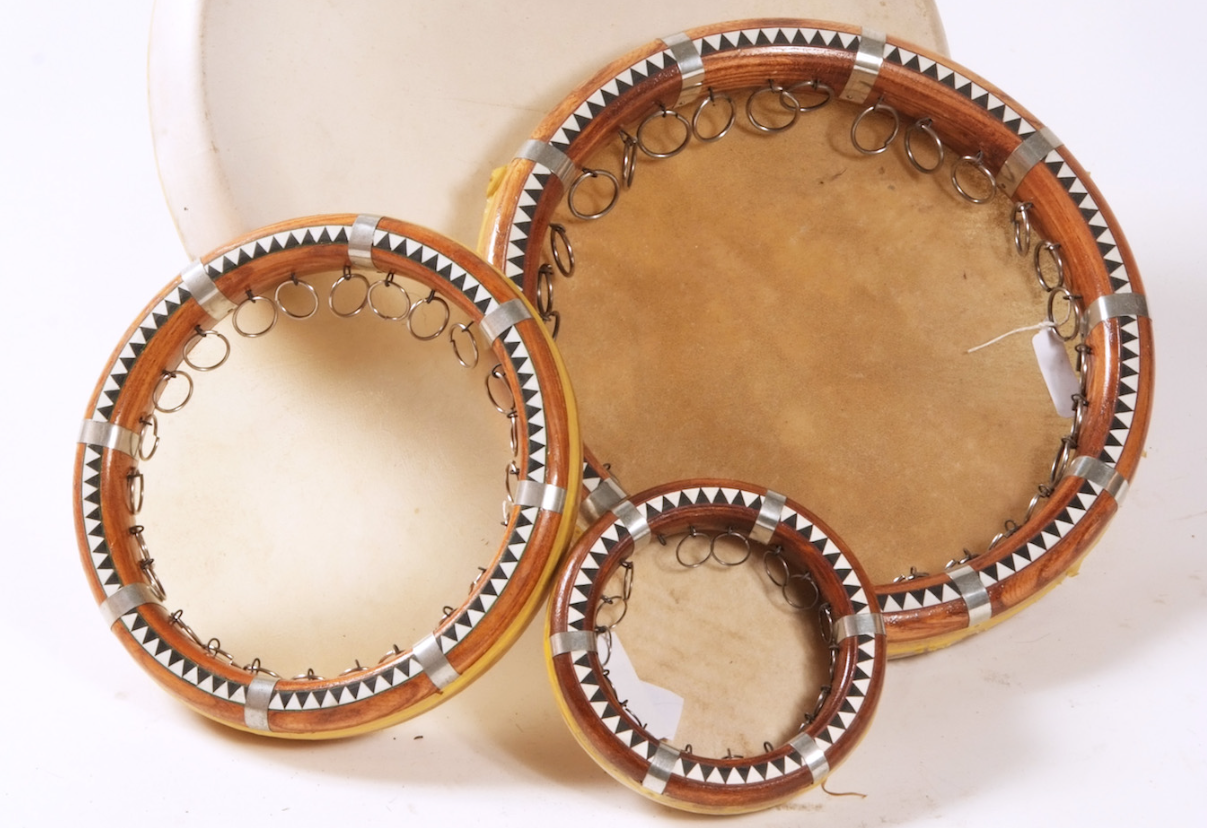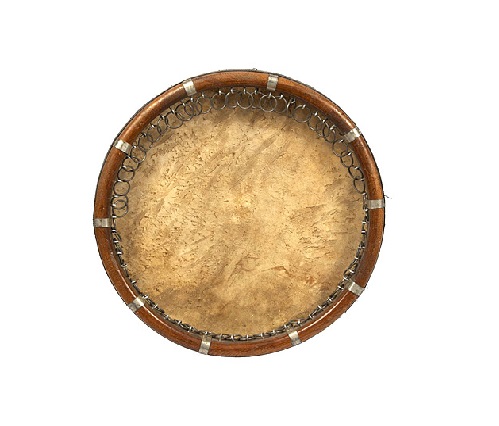Doyra
Percussions
Asia
Between 0 and 1000 AD
Video
The doyra is a traditional frame drum that holds a significant place in the musical heritage of Central Asia, particularly in Uzbekistan. This instrument is characterized by its circular shape and is classified as an idiophone, meaning it produces sound primarily through the vibration of its own body rather than through a membrane.
It typically features a wooden frame, which is covered on one side with animal skin, usually goat or calf hide. The frame is often adorned with metal rings or jingles that enhance its sound and provide additional rhythmic texture.The doyra is versatile in its musical applications, capable of being played solo or as part of an ensemble. It is commonly used in various musical genres, including folk music, classical performances, and contemporary fusion styles. The instrument’s ability to produce a wide range of tones—from deep bass to sharp treble—makes it an essential component in many musical traditions across Central Asia.
History and Origins
The history of the doyra dates back centuries, with its origins believed to be in Central Asia. While exact dates are difficult to ascertain, evidence suggests that similar instruments have been used since at least the 2nd century BC, as depicted in terracotta monuments found in regions such as Nisa. The doyra has been an integral part of the cultural fabric of Uzbekistan and surrounding areas for generations, evolving alongside the musical traditions of the region.Historically, the doyra was predominantly played by women during ceremonial occasions such as weddings and festivals. However, by the end of the 18th century, men began to take on a more prominent role as players, which led to adaptations in the instrument’s size and construction to suit dance music. Today, the doyra remains a vital instrument in both traditional and modern contexts, reflecting its enduring significance within Central Asian culture.
Materials Used in Construction
The construction of the doyra involves several materials that contribute to its unique sound quality:
- Wood: The frame is typically made from hardwoods such as apricot or walnut, known for their durability and resonance.
- Animal Skin: The drumhead is commonly made from goat or calf skin, providing a rich tonal quality when struck.
- Metal Rings: Attached to the frame are metal rings or jingles that enhance the instrument’s sound by adding brightness and texture.
These materials are carefully selected not only for their acoustic properties but also for their availability in the region. Artisans skilled in traditional crafting techniques create each doyra with attention to detail, ensuring that it meets both aesthetic and functional standards.
Types of Doyras
There are several types of doyras based on size, construction, and regional variations:
Traditional Doyra: This version adheres closely to historical designs with wooden frames and animal skin heads.
Modern Doyra: Incorporates synthetic materials for durability while maintaining traditional sound characteristics.
Regional Variants: Different cultures may have their own adaptations of the doyra; for example, it may be referred to as “duff” or “riq” in other regions.
Each type serves different musical purposes and reflects local craftsmanship traditions.
Features of the Doyra
The doyra consists of a large, circular frame drum with two heads made from animal skin, typically goat or camel. The skin is stretched tightly over the wooden frame, which is often decorated with intricate designs. The size of the doyra can vary, but it generally has a diameter ranging from 12 to 20 inches.
One of the most distinctive features of the doyra is its wide range of sounds, which are produced by striking the drum with the hands, fingers, or sometimes with mallets. The player often strikes both the center and the edges of the drumheads to produce contrasting tones—deep and resonant in the middle and sharper, higher-pitched sounds near the rim. The instrument can also produce a subtle “buzzing” sound when played by pressing the frame lightly against the player’s body or using certain playing techniques. The doyra is an essential rhythmic instrument in various forms of traditional Central Asian music, especially in the context of folk ensembles, dances, and religious ceremonies. Its ability to produce rich, layered rhythms makes it ideal for accompanying both fast-paced, energetic music and slower, meditative pieces. Due to its portability and simple yet effective design, the doyra remains a key part of the musical heritage in the region.
Playing Methods
Playing the doyra involves several techniques that require skillful hand coordination:
Finger Strikes: Musicians use their fingers to strike different parts of the drumhead for varied tonal effects.
Palm Techniques: The palms can be used for softer sounds or to create a muted effect.
Shaking Motion: Shaking the instrument introduces jingles into the rhythm, enhancing texture.
Dynamic Control: Players can achieve a range of dynamics from soft whispers to powerful beats by adjusting their playing style.
Mastering these techniques allows musicians to create intricate rhythms essential for accompanying vocalists or other instruments.
Kind of Music Composed
It is made from clay, the ghatam has a distinctive, resonant tone that adds depth and rhythmic complexity to performances. In Carnatic music, the ghatam is often used as a complementary instrument to the mridangam, contributing to intricate rhythmic patterns and enhancing the overall percussion ensemble. It is played by striking the body and mouth of the instrument with the fingers, palms, and the edges of the hands, creating a variety of sounds, from deep resonant thuds to sharp, crisp tones. Beyond classical Carnatic music, the ghatam has been incorporated into fusion genres, blending traditional rhythms with contemporary forms such as jazz, world music, and experimental music. In fusion settings, the ghatam is often paired with instruments from other cultures, and it plays a key role in creating unique rhythmic textures and grooves. The instrument’s versatility allows it to adapt to both solo and ensemble contexts, adding both rhythmic and melodic elements to compositions. Whether in traditional Indian classical concerts or in global collaborations, the ghatam remains a vital instrument, contributing rich, earthy tones that are integral to the rhythms of many musical styles.
Roles in Music
The doyra, a traditional percussion instrument from Central Asia, particularly popular in Uzbekistan, Tajikistan, and other parts of the region, plays a significant role in both folk and contemporary music. It is a large, double-headed drum made from wood and animal skin, typically played with the hands or with sticks. The doyra’s primary role in music is to provide rhythmic foundation and drive, supporting melodies and harmonies from other instruments. In ensemble settings, it often sets the tempo and rhythm for dances and song performances, contributing to the overall structure and energy of the music.
The doyra is particularly important in the accompaniment of traditional dance forms, where its rapid and complex rhythms enhance the dynamic movements of dancers. In classical and folk music, the instrument adds a percussive texture that complements string and wind instruments, blending into a harmonious and vibrant performance. The sound of the doyra, with its deep resonance and sharp, high-pitched tones, is capable of creating intricate polyrhythmic patterns that energize the music and create a compelling rhythmic framework. In addition to its role in folk and classical traditions, the doyra has found a place in modern music, often used in contemporary fusion genres to bring traditional Central Asian rhythms into new musical contexts. Its versatility and rich tonal qualities make it an essential instrument in both preserving and innovating the musical traditions of Central Asia.
The doyra is more than just a percussion instrument; it represents centuries of tradition intertwined with cultural significance across Central Asia. Its unique construction, versatile playing techniques, and vibrant sound make it an integral part of Uzbek music while allowing it to adapt to contemporary genres. As musicians continue to explore its possibilities, the doyra remains a vibrant symbol of artistic expression and heritage.
FAQ
What is the Doyra made of?
The Doyra is traditionally made from a wooden frame with animal skin stretched over it. The skin is often from goats or sheep. The materials contribute to the drum's rich, resonant sound. The craftsmanship involves careful tuning of the skin to ensure the right tonal quality.
What type of musical instrument is the Doyra?
The Doyra is a percussion instrument, typically used in Central Asian music. It is a type of drum, categorized as a frame drum. The instrument is known for its deep, resonant tones and is played with the hands or sticks. It is vital in traditional music performances and dances.
What type of music is the Doyra used in?
The Doyra is primarily used in folk and traditional music, especially in Uzbekistan, Tajikistan, and Kyrgyzstan. It accompanies dances and other performances. The drum is integral to celebratory music and rituals, offering a driving rhythm that guides the performers.
 Links
Links
References
Other Instrument
Categories



















